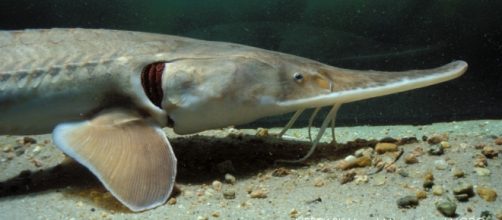Environmentalists are expected to step up opposition to the construction of a dam on the Yellowstone River near Glendive, Montana, contending the project could cause the extinction of the wild Pallid Sturgeon. The dam, to be located approximately 390 miles northeast of Yellowstone National Park, was given approval last month by the U.S. Army Corps of Engineers and the U.S. Bureau of Reclamation. A court battle over the issue is pending.
Spokesmen for the environmental groups Defenders of Wildlife and the National Resource Defense Counsel at a court hearing this week, said they will negotiate with dam builders on how to proceed.
It appears they are attempting to stall the proposed $57 million dam project. The future of the fish appears to hang in the balance.
The future of the Pallid Sturgeon could be decided in court
Last year the environmentalists filed a lawsuit against the dam project and Montana District Judge Brian Morris temporarily blocked the start of construction. His approval must be gained before work can begin. The dam is supposed to supply diverted water to farmers who produce wheat, alfalfa, beets and other crops.
One of the longest-living fish, the Pallid Sturgeon is also one of the rarest. A species that has existed in the area since the time of the dinosaurs, the pallid sturgeon is native to the Missouri and Mississippi rivers and appears much like a small shark with a rear dorsal fin.
The animal can live up to 50 years and attain a size of six feet.
The proposed dam installation on the Yellowstone River (a tributary of the Missouri River) would include a bypass canal to allow the sturgeon to get around the dam. However, wildlife advocates said there is no certainty the fish would use it. Numbers of wild pallid sturgeon have dwindled in recent years due to habitat loss. Scientists said if the fish does not use the bypass, it could be blocked from its upstream spawning grounds.
The Pallid Sturgeon has to make it upstream to breed
Fewer than 125 of the fish have been counted at the site and many of the animals are decades old; female Pallid Sturgeons customarily do not spawn until they reach the age of 15-years-old.
Scientists have warned that they could disappear entirely unless they have adequate opportunities to spawn.
Farmers in Montana and North Dakota are already using water at the site provided by a rock weir (a barely visible low-lying wall) that diverts water into canals for use in agricultural fields. The weir system was originally built in 1909. New construction would install a full-blown concrete dam. An alternative proposal, taking out the rock weir and installing pumps to divert water without a dam was rejected for being too costly.
Sturgeons raised in hatcheries are released into the Yellowstone River, though, whether the planted fish are migrating and spawning the way native fish do, remains uncertain. Dam bypasses have been used at other locations for salmon with mixed results, but never before in the case of the Pallid Sturgeon.

